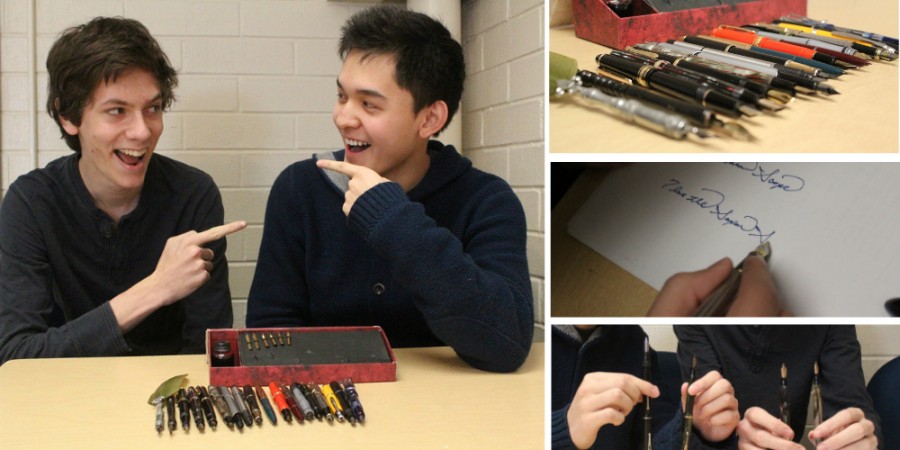As I’m interviewing senior Michael Guo and taking notes, he stares at me suspiciously.
“I kind of want to break that thing in your hand,” he says matter-of-factly.
I look down. It’s a ballpoint pen. “Ballpoints are the scourge of the Earth,” adds his close friend, senior Paul Bernstein, sternly.
Guo and Bernstein are both avid fountain pen collectors. They got started last summer and have bonded over their hobby. They now have collections worth about $2,000 put together.
“You can pretty much do anything with [fountain pens]. You eventually have to throw out ballpoint pens, but fountain pens stay with you forever,” said Bernstein.
According to him and Guo, the distinguishing features of fountain pens are that they can be refilled with ink, and that their tips are pointed pieces called “nibs.” Ballpoint pens, on the other hand, have a small ball at the tip that is used for writing.
Fountain pens can be pricey; some models cost hundreds of thousands of dollars. Guo’s most expensive pen cost $200, while Bernstein’s was $300. “Most of my pens are around $150, while Paul’s are $200 to $300,” said Guo. “I have eleven pens, and Paul has twelve. My pens aren’t insured, I like to live on the edge.”
Guo and Bernstein purchase their pens through eBay, Amazon, stores like Paradise Pen and pen conventions. “We went to a pen show in Baltimore recently,” said Bernstein. “Shows sell tons of pens. You also get to meet erudite scholars and nibmeisters, who are people that fix broken pens.”
Collecting pens has lots of perks for these two seniors. Bernstein used his pens to impress his college interviewers. “We made small talk about the pens for a while,” he said.
Guo wrote his college essay on pens. “I talked about how trying new pens is like meeting new people,” he said. “Some are great, and some are horrible and ugly and don’t work.”
Guo was even offered a job at Paradise Pen. “I went in to the store and ended up talking to the people there for an hour, and they pulled out a job application for me,” he said. Guo ended up not taking the job because he didn’t have enough time to work.
Not only are Guo and Bernstein huge pen enthusiasts, they make sure to use high-quality paper when they write. Bernstein prefers Rhodia journals, which cost $25 each. “Writing with fountain pens is much more pleasant with nicer paper. I use Rhodia paper for all my homework.”
Ink is another important accessory for Guo and Bernstein. Bottles of ink can cost anywhere from $10 to $30, according to Guo. There are also a variety of colors to choose from, such as Bay State Blue or Black Cherry.
The two are protective of their collections. At one point, I tried to pick up one of Bernstein’s pens to get a closer look. “Don’t break that,” he said nervously.
Guo and Bernstein are also careful about lending out their pens. “I’ll give someone a crappy pen if I don’t trust them. They don’t realize that I’m insulting them,” laughed Guo.
For Guo, caution is especially important, since he brings $1,000 worth of pens to school every day in a beat up black pencil pouch. He does this so he can keep his collection with him, instead of leaving it lying unattended at home. Bringing such a high-value collection doesn’t worry Guo, though. “Even if a big, [huge] guy came after my pens, I would tear him apart,” he said.
Both Guo and Bernstein plan to keep collecting for a long time. “We’re trying to spread the pen movement,” said Bernstein. “I’d spend any amount of money on a pen.”
[nggallery id=263]
Photos by Aimee Cho


